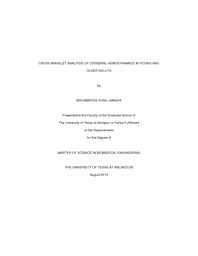
ATTENTION: The works hosted here are being migrated to a new repository that will consolidate resources, improve discoverability, and better show UTA's research impact on the global community. We will update authors as the migration progresses. Please see MavMatrix for more information.
Show simple item record
| dc.contributor.author | Gandhi, Mrunmayee Sunil | en_US |
| dc.date.accessioned | 2014-09-17T17:28:38Z | |
| dc.date.available | 2014-09-17T17:28:38Z | |
| dc.date.issued | 2014-09-17 | |
| dc.date.submitted | January 2014 | en_US |
| dc.identifier.other | DISS-12823 | en_US |
| dc.identifier.uri | http://hdl.handle.net/10106/24702 | |
| dc.description.abstract | Measurement of cerebral autoregulation is important for the evaluation of a number of clinical disorders that affect cerebral blood flow. Cerebral autoregulation is a mechanism that involves dilation and constriction in arterioles to maintain relatively stable cerebral blood flow in response to changes of systemic blood pressure. Traditional assessments of autoregulation focus on the changes of cerebral blood flow velocity in response to large blood pressure fluctuations induced by interventions. This approach is not feasible for patients with impaired autoregulation or cardiovascular regulation. Therefore in this thesis, a non-stationary time-frequency analysis method, Cross Wavelet Transform is used, which assess autoregulation by nonlinear phase interactions between spontaneous oscillations at resting state and induced oscillations during repeated sit-stand activity in cerebral hemodynamic variables and blood pressure. In ten healthy young (22-28 years) and ten healthy older adults (70-80 years), blood pressure was continuously measured in the finger by photoplethysmography, cerebral blood flow velocity was measured in the middle cerebral artery (transcranial Doppler ultrasonography) and cerebral cortical oxygenated hemoglobin (HbO) was also measured using fNIRS, during 5 min resting state and again during repeated sit-stand maneuvers at 0.05 Hz. Cross wavelet phase and coherence was calculated between young and older subjects during resting state and during repeated sit-stand activity for BP vs., TCD and TCD vs. HbO at very-low-frequency oscillations (0.045-0.055 Hz), low-frequency oscillations (0.09-0.11 Hz) and high-frequency oscillations (0.2-0.3 Hz). It is observed that, the magnitude of oscillations increased during repeated sit-stand activity as compared to baseline oscillations in both young and older adults. These large magnitude oscillations led to an increase in wavelet coherence compared with spontaneous oscillations (baseline) from 0.48 to 0.96 for repeated sit-stand activity at 0.05 Hz (p<0.05), allowing for more confident assessment of cerebral autoregulation through cross wavelet phase analysis. Cross wavelet analysis indicated that the relationship between BP and cerebral hemodynamic oscillations does not change under influence of age and physical load. There is no significant statistical difference between young and older subjects during baseline and also during repeated sit-stand activity for BP and hemodynamic variables. The results in this thesis suggest aging-related changes in the microvasculature such as declined spontaneous activity in micro vascular smooth muscle cells and vessel stiffness. Moreover, our results indicate that in addition to local vasoregulatory processes, systemic processes also influence cerebral hemodynamic signals. It is therefore crucial to take the factors of age and BP into consideration for the analysis and interpretation of cerebral hemodynamic data. This study aims to assess the relationship between BP vs. TCD and TCD vs. HbO during spontaneous oscillations and during repeated sit-stand oscillations in healthy young and elderly subjects cross wavelet phase and coherence analysis. | en_US |
| dc.description.sponsorship | Liu, Hanli | en_US |
| dc.language.iso | en | en_US |
| dc.publisher | Biomedical Engineering | en_US |
| dc.title | Cross Wavelet Analysis Of Cerebral Hemodynamics In Young And Older Adults | en_US |
| dc.type | M.S. | en_US |
| dc.contributor.committeeChair | Liu, Hanli | en_US |
| dc.degree.department | Biomedical Engineering | en_US |
| dc.degree.discipline | Biomedical Engineering | en_US |
| dc.degree.grantor | University of Texas at Arlington | en_US |
| dc.degree.level | masters | en_US |
| dc.degree.name | M.S. | en_US |
Files in this item
- Name:
- Gandhi_uta_2502M_12823.pdf
- Size:
- 2.024Mb
- Format:
- PDF
This item appears in the following Collection(s)
Show simple item record


